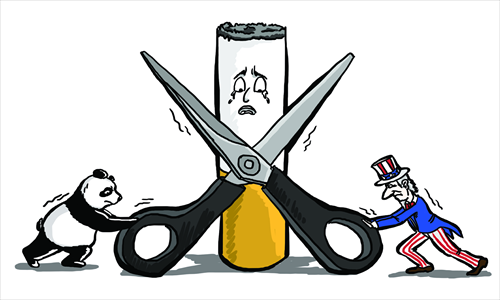China and US partner against smoking

Tobacco use is the leading cause of preventable death and disease in the US and China, and it kills 6 million people each year worldwide. Of these deaths, 600,000 are due to secondhand smoke. Tobacco use is estimated to cause 443,000 deaths annually in the US. In China, more than 1 million people die from tobacco use each year, including more than 100,000 victims of secondhand smoke.
China has made significant strides in tobacco control in recent years. China has recently been praised by the World Health Organization (WHO) for the Ministry of Health's (MOH) release of the "China Report on the Health Hazards of Smoking." Earlier this year, the "Say No to Forced Smoking" campaign, launched by the Bill and Melinda Gates Foundation and web services corporation Baidu, drew significant attention to the 100,000 annual deaths caused by secondhand smoke in China.
Committed to reducing the devastating effects of tobacco use, China and the US have both made progress toward enhanced tobacco control. China ratified the WHO's Framework Convention on Tobacco Control (FCTC) in 2003 and enacted it in January 2006. Since then, health education campaigns have been carried out throughout China, and relevant regulations have been revised in support of the FCTC goals.
In 2009, the MOH, in collaboration with three other government partners, launched an initiative that established a tobacco-free health system. Working with the Ministry of Education, the MOH also established tobacco-free schools and, since then, smoke-free indoor spaces have gradually expanded.
Tobacco control was included in China's 12th Five-Year Plan (2011-15). Some municipalities and big cities have already passed tobacco control legislation and the MOH also established a national anti-smoking hotline. Since the launch four years ago of a continuous mass media campaign, more than 40,000 news stories on tobacco control have been published, which has greatly increased the public's knowledge on the heath risks of smoking.
A reinvigoration of national efforts has occurred in the US as well. In 2010, the US Department of Health and Human Services (HHS) unveiled its first-ever national strategic plan for tobacco control, entitled Ending the Tobacco Epidemic. The strategic plan already has led to an unprecedented set of actions throughout the HHS and the US government which, in turn, has increased access to tobacco cessation services while decreasing workers' exposure to secondhand smoke.
In July 2011, HHS expanded its existing smoke-free policy to protect the health of its employees, contractors, and visitors by prohibiting the use of any tobacco product in or near all of its facilities, including in nearby parking lots and in private vehicles on the premises. The US Office of Personnel Management, which is the human resources arm of the
Earlier this year, the US Centers for Disease Control and Prevention (US CDC) launched a landmark national advertising campaign that depicted the harsh realities of tobacco related illness. The campaign generated more than 200,000 additional calls to the 1-800-QUIT-NOW portal that links callers to their state tobacco cessation quitlines and more than 500,000 additional visitors to smokefree.gov, a federal website that helps people quit smoking.
Furthermore, in an effort to reach young adults, HHS collaborated with leaders of US academic institutions to increase the number of tobacco-or smoke-free campuses nationwide. The Tobacco-Free College Campus Initiative promotes and supports the adoption and implementation of tobacco-free policies at universities, colleges, and other institutions of higher learning.
Collectively, the
In collaboration with the WHO, the US CDC and China CDC in 2010 jointly conducted the most recent Global Adult Tobacco Survey in
We view the China-US Smoke-free Workplace Initiative as an exciting next step to further our cooperative efforts to reduce tobacco harm. The CUSW is unique from our previous partnerships in that it is a multi-sectoral, public-private partnership that combines the health expertise of Chinese and US health agencies with the workplace experience of businesses to create and support smoke-free workspaces. With help from our partners, we already have key businesses that have joined the initiative and are helping to make a positive change. The CUSW Initiative will support companies as they take steps to go smoke-free during the next year.
With the help of the business community, we hope to significantly reduce exposure to second-hand smoke, while raising awareness of the hazards of tobacco use and encouraging people to quit smoking.
We believe that the CUSW Initiative will not only provide a platform for a healthier workforce, but it will also help lead to a healthier environment in the community at-large. We look forward to this next step in our joint efforts toward a smoke-free world.
Dr. Huang Jiefu is the Vice Minister of Health in the People's Republic of